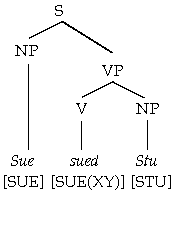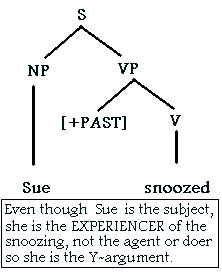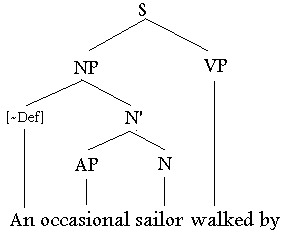Since semantic relations are distinct from syntactic ones, we use a special means of expressing semantic relations called predicate argument structure. Predicate argument structure is based on the function features of lexical items (most often verbs). The function features determine the thematic roles to be played by the other words in the sentence. However, function features and thematic roles don't always cooincide.
- A predicate specifies a relationship between objects (concrete or abstract) or a state that characterizes an object, e.g. [BIT(BOY, DOG)] 'the boy bit the dog'. A predicate may also be a property: [BIG{DOG}] 'the dog is big/a big dog'.
- Arguments refer to real-world objects
about which something is predicated; they are placed in parantheses after
predicates:
Lexical Entry Semantic Example Paraphrase RUN(X) = RUN(MARY) = Mary runs/ran/is running RED(X) = RED(CAR) = The car is/was/will be red MAKE(XY) = MADE(JOHN, TABLE) = John made the table IN(XY) = IN(SUE, HOUSE) = Sue is in the house MOTHER(X) = MOTHER(SUE) = Sue's mother/the mother of Sue
How then does semantics interpret a syntactic structure with lexical and grammatical content? Two things can occur, either semantics can be directly derived from the syntactic arrangement, or semantics rejects the overt syntactic relationships and moves to the next logical syntactic component.
- Semanatics Follows Syntax.
Generally, arguments fill predicates depending on their syntactic relation. In a simple sentence that uses a transitive verb (and therefore has both a subject NP and a direct object NP), the following occurs.
- The semantic content of the subject, the first NP under S, is mapped onto the 'X' argument of the function.
- The semantic content of the first NP under VP, the direct object,
is mapped onto the 'Y' argument.

- If the predicate takes an experiencer rather than an agent,
it will only have a 'Y' argument. (Note that this semantic structure
is different from the one posited with thematic roles only.)

- This example also shows that grammatical functions (e.g., [+Past], [-Definite], [+Demonstrative]) map onto semantic correlates which have argument structures, too.
- The compilation of semantic relations probably takes place in
the lexicon as words are selected for inclusion in the syntactic
tree.
- Sometimes Semanatics Doesn't Follow Syntax.
However, in these cases (which are not as common) semantics interprets syntactic structures by its own rules.- An occasional sailor walked by. The adjunct occasional in this phrase is a syntactic constituent of the NP headed by sailor; however, semantically it is an adjunct of the VP headed by walked.
- The Syntactic Structure:

- The syntactic structure shows that
- the argument for occasional (whose meaning is, presumably, [INFREQUENT(Y)]) should be sailor.
- But sailors can't be infrequent but walking by can be.
- So the semantic component follows its own rules and finds the
next head that can be infrequent, the V.

- What abou the adjunct in: Juanita read a sad story?